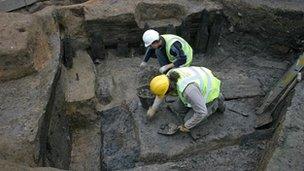York's Hungate dig nears completion
- Published

Viking cellars, used to store goods from across the world, will soon vanish beneath modern housing
An archaeological excavation that has unveiled 2,000 years of York's history is about to once again disappear underground.
The Hungate dig in York is the biggest urban excavation in the city for a quarter of a century and covers a 2,500 sq m (26,900 sq ft) area.
The York Archaeological Trust has spent five years working on the dig but will hand the site back to developers in December.
Viking age cellars and the remains of a Roman cemetery will vanish beneath a modern housing development in 2012.
Over the past five years more than 20,000 people have visited the site as archaeologists have uncovered a variety of artefacts which have shed more light on the history of York.
Rare finds
Hungate, close to the River Foss, has been under continuous occupation for most of the past 2,000 years.
Part of the site contains the remains of an early Roman cemetery which dates from around 1,700 years ago.
Project director Peter Connelly, said: "It is the largest Roman cemetery excavated in York for a century. We've discovered amazing pieces of Roman jewellery."

Some artefacts revealed York's importance as a centre of trade during the Viking period
The jewels discovered included a roman necklace consisting of 299 small glass beads and rare jet jewellery dating from the 3rd or 4th centuries.
Hungate has also revealed the edges of the Viking town of Jorvik where at one time warehouses would have stood ready to receive goods from across Europe.
Seven cellars have been uncovered and artefacts found include a very small glass bead, around one centimetre long.
Archaeologists believe it was made in the eastern Mediterranean between the 8th and 12th century and similar beads have been found in Viking graves in Scandinavia.
Mr Connelly said it was a rare find in the UK and raised a number of questions.
Communal toilet
He added: "It's travelled over 2,000 miles to get to York 1,000 years ago. Suddenly you've got that connection with the international trade that was happening in Jorvik 1,000 years ago."
The team have also been able to discover the edges of the medieval cemetery of the Church of St John's in the Marsh and the remains of clay pits which were likely from the brick and tile works that belonged to a nearby Carmelite monastery.
In later periods the site housed a medieval dump and market gardens.

A number of local residents have worked on the site as community archaeologists
By the 19th Century Hungate was a slum district with cheap and poorly constructed housing.
Archaeologists have unearthed the remains of a communal toilet block which would have served 11 households by 1907, according to records held in the city archives.
Full excavation revealed that this toilet was a Duckett's tipper flush toilet, initially manufactured in Burnley before being brought to York and assembled.
Mr Connelly said: "Obviously this area had become a tight-knit community and we see these toilets going in. Not only have we been able to excavate it but we can find out which households used it before the slum clearances in the 1930s."
The dig has cost more than £3m and was funded by the development company, Hungate (York) Regeneration Ltd.
Mr Connelly said the development had given them a rare opportunity to discover more of York's past.
He said: "This excavation has been an incredibly interesting and varied project uncovering all sorts of aspects of York's remarkable heritage.
"Eventually there will be a building above all of this but if it wasn't for that we would never have got to dig the site."